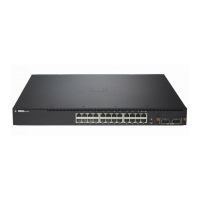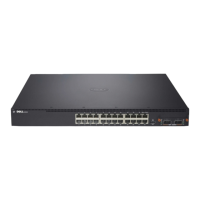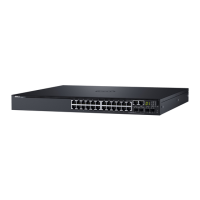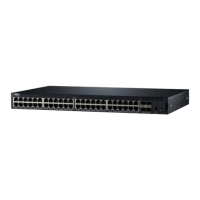Configuring OSPF and OSPFv3 1003
console(config)#interface vlan 17
console(config-if-vlan17)#ip address 10.2.4.2
255.255.255.0
console(config-if-vlan17)#ipv6 address
3000:2:4::/64 eui64
console(config-if-vlan17)#ipv6 ospf
console(config-if-vlan17)#ipv6 ospf areaid 2
console(config-if-vlan17)#exit
4
For IPv4: Configure the router ID, define an OSPF router, and define Area
1 as a stub., and define Area 2 as an NSSA.
console(config)#router ospf
console(config-router)#router-id 2.2.2.2
console(config-router)#area 0.0.0.1 stub
console(config-router)#area 0.0.0.2 nssa
5
For IPv4: Enable OSPF for IPv4 on VLANs 10, 5, and 17 by globally
defining the range of IP addresses associated with each interface, and then
associating those ranges with Areas 1, 0, and 2, respectively.
console(config-router)#network 10.1.2.0 0.0.0.255
area 0.0.0.1
console(config-router)#network 10.2.3.0 0.0.0.255
area 0.0.0.0
console(config-router)#network 10.2.4.0 0.0.0.255
area 0.0.0.2
6
For IPv4: Configure a metric cost to associate with static routes when they
are redistributed via OSPF:
console(config-router)#redistribute static metric
1 subnets
console(config-router)#exit
7
For IPv6: Define an OSPF router. Define Area 1 as a stub and area 2 as a
Not-So-Stubby-Area (NSSA). Configure a metric cost to associate with
static routes when they are redistributed via OSPF:
console(config)#ipv6 router ospf
console(config-rtr)#router-id 2.2.2.2
console(config-rtr)#area 0.0.0.1 stub
console(config-rtr)#area 0.0.0.2 nssa
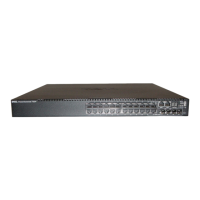
